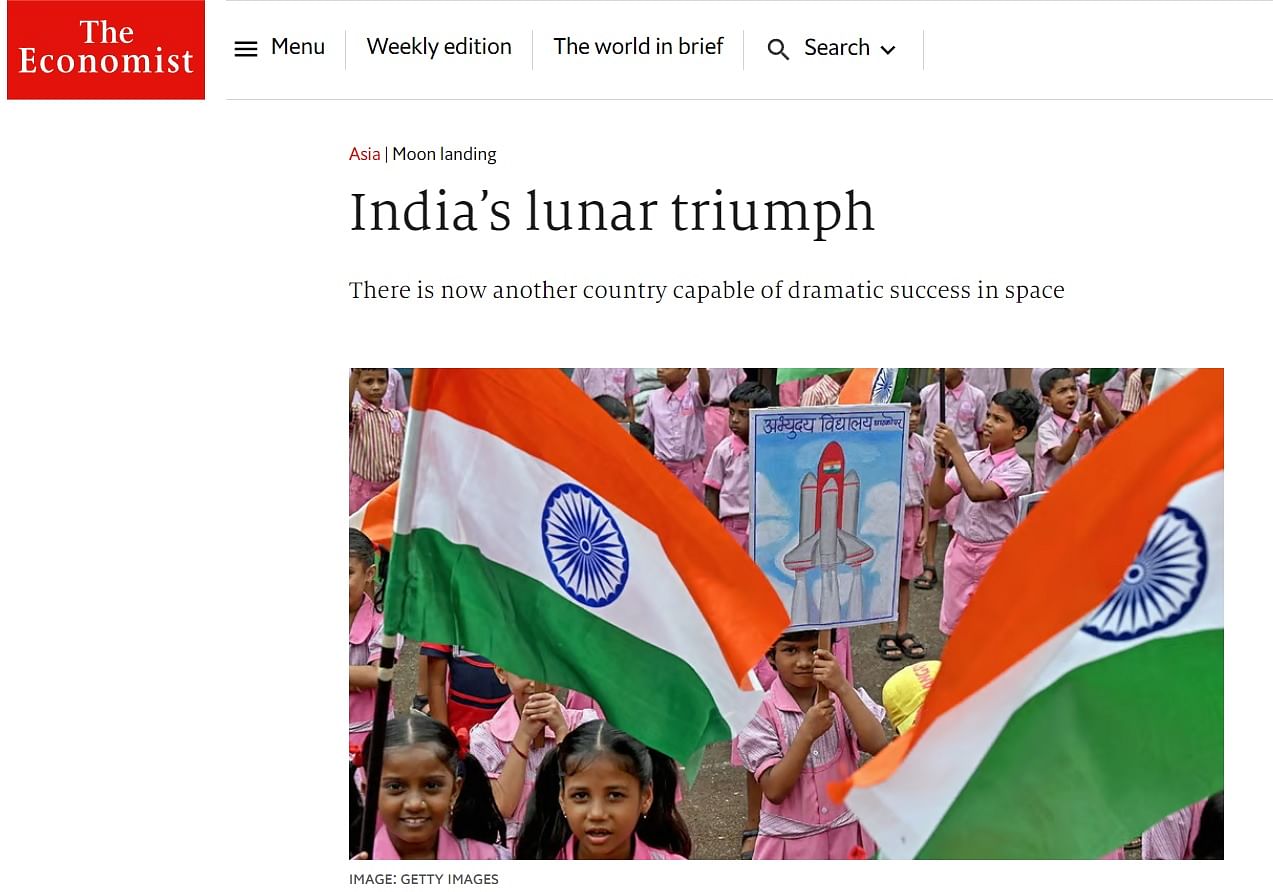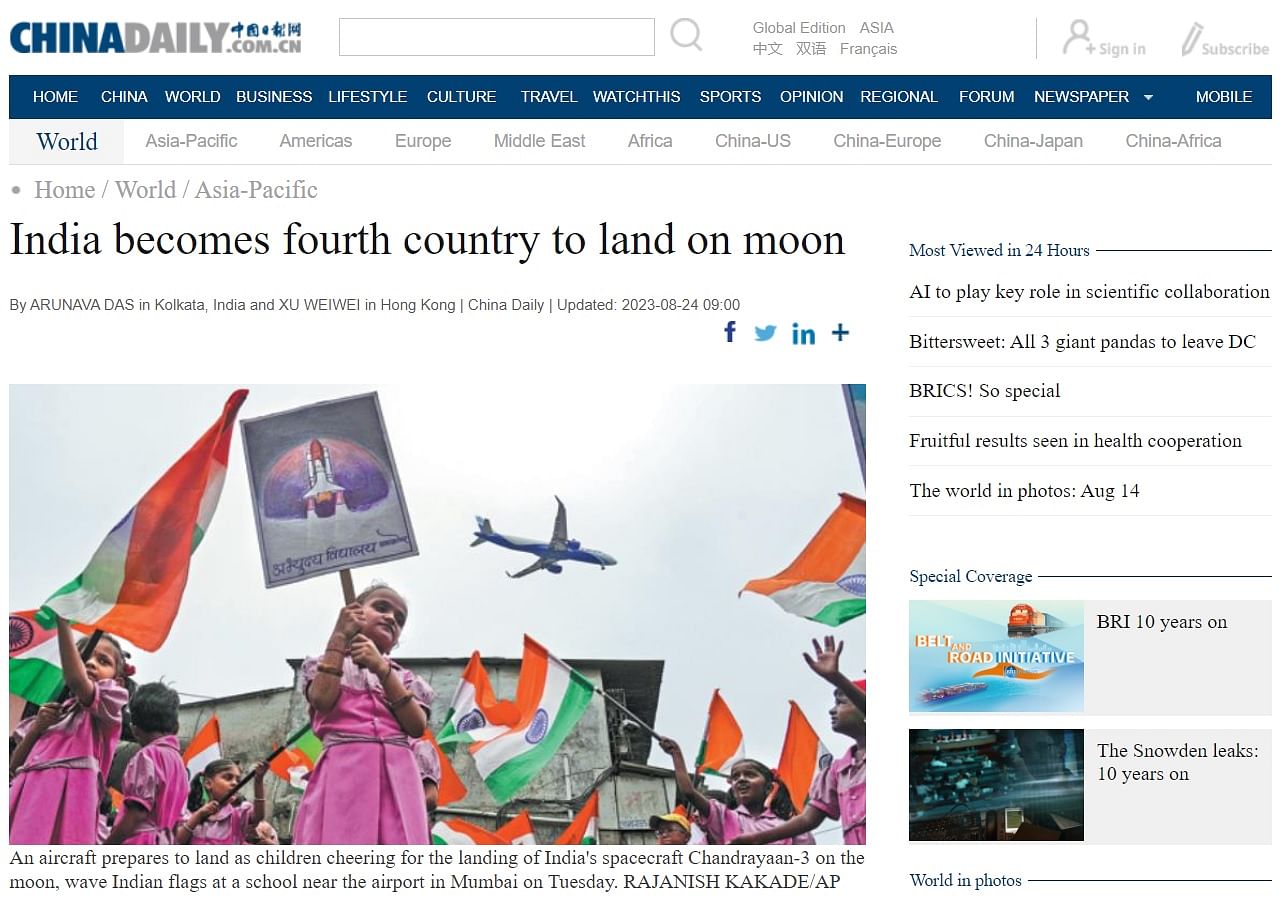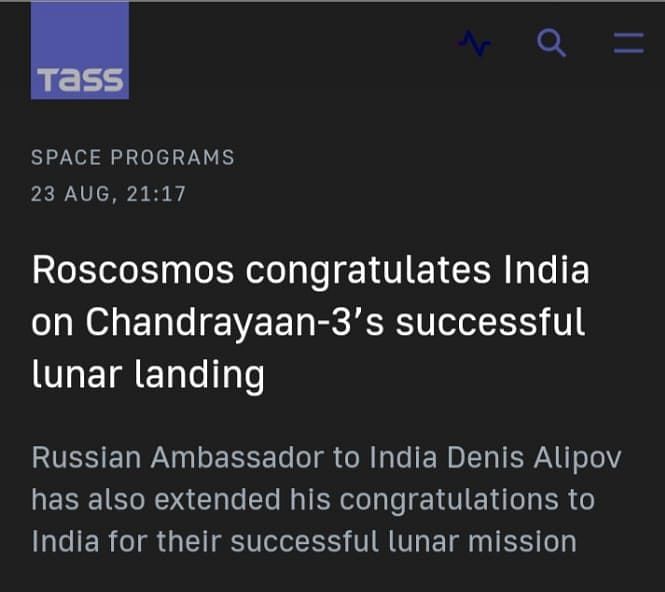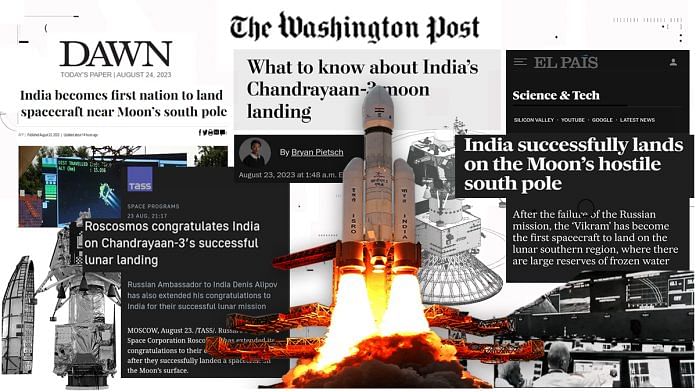Bengaluru: From the BBC’s Pidgin service in Nigeria to the world’s great newspapers in London, New York and Paris, media organisations have hailed the soft, silent landing of India’s Chandrayaan-3 with thundering headlines — its scientists winning the country applause that contrasts with the often-critical coverage of India’s politics and economy on global front pages in recent years.
The cheer wasn’t entirely universal: The sole official media outlet for North Korea somewhat grumpily carried no news at all of the landing, perhaps because the country’s second effort to launch a spy-satellite failed just ahead of the landing.
But news organisations from Australia to Zambia — some relying on translated stories harvested from news agencies, but many generating their own — devoted space to explaining the significance of the landing to their readers.
The Economist reported that “India’s lunar triumph” signalled that “there is now another country capable of dramatic success in space”, and flagged the confidence of scientists. “You don’t include a window showing the prime minister’s real-time reaction in the live YouTube feed of your lunar landing unless you think you are going to give him something to smile about,” read the opening lines of the piece.

Experts have long raised questions over racism in western coverage of science — and especially space — from less developed countries. This played out quite prominently when The New York Times published its infamous and much-criticised “elite space club” cartoon after India’s Mars mission was declared successful in 2014.
This time, though, the coverage has given Indians little to complain about — suggesting the criticism has been heard by editorial boards across the world.
Learning from the 2014 controversy, perhaps, The New York Times reported that the “Lander’s Success Moves Nation to Next Space Chapter”, placing the mission in the context of India’s wider strategic ambitions and foreign policy. Instead of clichéd contrasts with Indian poverty — a stock in trade for an earlier generation of journalists — the piece also described India’s deep tradition of science.
For The Washington Post, India’s lunar mission was also significant from a geopolitical context, with the newspaper contrasting its success with the failure of Russia’s Luna 25 mission last week, and the one-time superpower’s efforts to reenter the space race. The report also flagged India’s “growing ambitions in space”.

The Spanish-language El Pais, widely read both in the country and across Latin America, generally devotes limited space to news from Asia. El Pais, though, had an extended article by specialist science journalist Nuno Dominguez explaining in detail the scientific data the mission is expected to harvest.
Also Read: Curious about what Chandrayaan-3 aims to do? All about its payloads & how they’ll help scientists
‘Historic first’
The British BBC’s headline declared “India makes historic landing near Moon’s south pole”, although the first line did say India has joined an “elite club of countries” to achieve a soft landing.
Soft landings on the Moon fail for various reasons, with space agencies having always attempted them more than once. India is now one of four countries along with USSR/Russia, US, and China to make a controlled landing on the Moon.
Given the extensive network of BBC language services, its stories probably had among the widest reach: “India don dey Moon now,” reported BBC News Pidgin in Nigeria, quoting from PM Modi’s speech.
The Guardian, among the most trenchant Western critics of Prime Minister Narendra Modi’s government, was generous with its praise of Chandrayaan-3, headlining their report “India lands spacecraft near south pole of moon in historic first” . The laudatory article also includes some informative graphics that outline lunar landings and the structure of the Indian mission.
Another Guardian headline talked about the business of space with a strap that said India will “now be seen as a low-cost provider” for missions. The cost-efficiency of ISRO is not news to Indian readers, and keeping costs low has been one of the prime objectives as well as the USP of the Indian space programme.
The piece does make an important point, though — the organisation’s success comes at a time when funding is becoming a major issue in more mature space economies like the US, with privatisation of launches becoming common.
For the Australian Broadcasting Corporation, the star of the “historic landing” were celebratory Indians, of whom it carried several images. The piece also noted that ISRO had achieved success on a tight budget.

The success of the mission sparked similar excitement in other countries with a large Indian diaspora. Suriname’s Dagblad Suriname, read by a very large Indian diaspora, carried a report about how India became the fourth country to land on the Moon, and the first to soft-land near its south pole.
The tone was less celebratory in important Chinese publications, which flagged Beijing’s much-earlier success in landing multiple landers and two rovers on the Moon.
There were also factual accounts such as the one from China Daily, which simply read, “India becomes the fourth country to land on moon”. The piece described the difficulties of landing, India’s stature globally, and the potential to prospect for rare minerals like Helium.

Even though Russia is still mourning the loss of Luna 25, its scientists and politicians were gracious in defeat, with space agency Roscosmos offering ISRO congratulations through the country’s official news agency, TASS. There was relatively thin coverage, though, of the Indian mission.

The Taiwan Times carried a Reuters story describing the achievement as a “victory cry” for new India, and focusing on the nervous and jubilant mood before and after launch. The Korea Times also carried a report focusing on the significance of the landing, but South Korea’s news was dominated soon by the failure of the North Korean satellite launch.
Meanwhile, closer to home, some of the highest praise came from Pakistani publications and netizens. Even though much of the content was republished from international agencies, the headlines were celebratory, with The Dawn titling its report “India becomes the first nation to land spacecraft near Moon’s south pole”.

Daily Pakistan called it a “historic moment for India” in its headline, and the Express Tribune — carrying a Reuters copy — referred to it the same way.
The reporting in West Asian publications was also celebratory. Asharq al-Awsat, a Gulf news publication based out of London, praised the Indian space programme’s achievement and carried information about the celebrations in India, much like AFP.
Al Jazeera, too, carried a piece titled “Chandryaan-3 makes space history”, along with a live-blog of the coverage. The UAE’s The National talked about a race to the lunar south pole, and India’s space ambitions.
Algeria’s ElKhabar posted a simple update titled “Historic Day: India lands on the moon”.
(Edited by Sunanda Ranjan)
Also Read: Chandrayaan-3 landing done. It’s now over to Pragyan Rover for next phase of Moon mission






